A Causal Treatment for X-Linked Hypohidrotic Ectodermal Dysplasia: Long-Term Results of Short-Term Perinatal Ectodysplasin A1 Replacement
Abstract
1. Introduction
2. Results
2.1. Induction of Sweat Gland Development and Sweating Ability
2.2. Impact of EDA1 Replacement on Other XLHED Symptoms
2.3. Absence of Functional EDA1 in the Circulation of Treated Patients
3. Discussion
4. Materials and Methods
4.1. Investigational Medicinal Product
4.2. Therapeutic Interventions Studied
4.3. Assessment of Sweat Gland Density and Function
4.4. Infrared Thermography
4.5. Determination of EDA Concentrations in the Blood
4.6. Immunoprecipitation of Circulating EDA and Western Blot
Author Contributions
Funding
Institutional Review Board Statement
Informed Consent Statement
Data Availability Statement
Acknowledgments
Conflicts of Interest
References
- Wright, J.T.; Fete, M.; Schneider, H.; Zinser, M.; Koster, M.I.; Clarke, A.J.; Hadj-Rabia, S.; Tadini, G.; Pagnan, N.; Visinoni, A.F.; et al. Ectodermal dysplasias: Classification and organization by phenotype, genotype and molecular pathway. Am. J. Med. Genet. Part A 2019, 179, 442–447. [Google Scholar] [CrossRef] [PubMed]
- Peschel, N.; Wright, J.T.; Koster, M.I.; Clarke, A.J.; Tadini, G.; Fete, M.; Hadj-Rabia, S.; Sybert, V.P.; Norderyd, J.; Maier-Wohlfart, S.; et al. Molecular pathway-based classification of ectodermal dysplasias: First five-yearly update. Genes 2022, 13, 2327. [Google Scholar] [CrossRef] [PubMed]
- Freire-Maia, N.; Pinheiro, M. Precocious mortality in Christ-Siemens-Touraine syndrome. Am. J. Med. Genet. 1990, 37, 299. [Google Scholar] [CrossRef] [PubMed]
- Blüschke, G.; Nüsken, K.-D.; Schneider, H. Prevalence and prevention of severe complications of hypohidrotic ectodermal dysplasia in infancy. Early Hum. Dev. 2010, 86, 397–399. [Google Scholar] [CrossRef]
- Kere, J.; Srivastava, A.K.; Montonen, O.; Zonana, J.; Thomas, N.; Ferguson, B.; Munoz, F.; Morgan, D.; Clarke, A.; Baybayan, P.; et al. X-linked anhidrotic (hypohidrotic) ectodermal dysplasia is caused by mutation in a novel transmembrane protein. Nat. Genet. 1996, 13, 409–416. [Google Scholar] [CrossRef]
- Mikkola, M.L.; Thesleff, I. Ectodysplasin signaling in development. Cytokine Growth Factor Rev. 2003, 14, 211–224. [Google Scholar] [CrossRef]
- Dietz, J.; Kaercher, T.; Schneider, A.T.; Zimmermann, T.; Huttner, K.; Johnson, R.; Schneider, H. Early respiratory and ocular involvement in X-linked hypohidrotic ectodermal dysplasia. Eur. J. Pediatr. 2013, 172, 1023–1031. [Google Scholar] [CrossRef]
- Wohlfart, S.; Meiller, R.; Hammersen, J.; Park, J.; Menzel-Severing, J.; Melichar, V.; Huttner, K.; Johnson, R.; Porte, F.; Schneider, H. Natural history of X-linked hypohidrotic ectodermal dysplasia: A 5-year follow-up study. Orphanet J. Rare Dis. 2020, 15, 7. [Google Scholar] [CrossRef]
- Gaide, O.; Schneider, P. Permanent correction of an inherited ectodermal dysplasia with recombinant EDA. Nat. Med. 2003, 9, 614–618. [Google Scholar] [CrossRef]
- Hermes, K.; Schneider, P.; Krieg, P.; Dang, A.; Huttner, K.; Schneider, H. Prenatal therapy in developmental disorders: Drug targeting via intra-amniotic injection to treat X-linked hypohidrotic ectodermal dysplasia. J. Invest. Dermatol. 2014, 134, 2985–2987. [Google Scholar] [CrossRef]
- Blecher, S.R. Anhidrosis and absence of sweat glands in mice hemizygous for the Tabby gene: Supportive evidence for the hypothesis of homology between Tabby and human anhidrotic (hypohidrotic) ectodermal dysplasia (Christ-Siemens-Touraine syndrome). J. Invest. Dermatol. 1986, 87, 720–722. [Google Scholar] [CrossRef] [PubMed]
- Casal, M.L.; Lewis, J.R.; Mauldin, E.A.; Tardivel, A.; Ingold, K.; Favre, M.; Paradies, F.; Demotz, S.; Gaide, O.; Schneider, P. Significant correction of disease after postnatal administration of recombinant ectodysplasin A in canine X-linked ectodermal dysplasia. Am. J. Hum. Genet. 2007, 81, 1050–1056. [Google Scholar] [CrossRef] [PubMed]
- Mauldin, E.A.; Gaide, O.; Schneider, P.; Casal, M.L. Neonatal treatment with recombinant ectodysplasin prevents respiratory disease in dogs with X-linked ectodermal dysplasia. Am. J. Med. Genet. Part A 2009, 149, 2045–2049. [Google Scholar] [CrossRef] [PubMed]
- Margolis, C.A.; Schneider, P.; Huttner, K.; Kirby, N.; Houser, T.P.; Wildman, L.; Grove, G.; Schneider, H.; Casal, M.L. Prenatal treatment of X-linked hypohidrotic ectodermal dysplasia using recombinant ectodysplasin in a canine model. J. Pharmacol. Exp. Ther. 2019, 370, 806–813. [Google Scholar] [CrossRef]
- Körber, I.; Klein, O.; Morhart, P.; Faschingbauer, F.; Grange, D.; Clarke, A.; Bodemer, C.; Maynard, J.; Maitz, S.; Huttner, K.; et al. Safety and immunogenicity of Fc-EDA, a recombinant ectodysplasin A1 replacement protein, in human subjects. Br. J. Clin. Pharmacol. 2020, 86, 2063–2069. [Google Scholar] [CrossRef]
- Schneider, H.; Faschingbauer, F.; Schuepbach-Mallepell, S.; Körber, I.; Wohlfart, S.; Dick, A.; Wahlbuhl, M.; Kowalczyk-Quintas, C.; Vigolo, M.; Kirby, N.; et al. Prenatal correction of X-linked hypohidrotic ectodermal dysplasia. N. Engl. J. Med. 2018, 378, 1604–1610. [Google Scholar] [CrossRef]
- Wünsche, S.; Jüngert, J.; Faschingbauer, F.; Mommsen, H.; Goecke, T.; Schwanitz, K.; Stepan, H.; Schneider, H. Non-invasive prenatal diagnosis of hypohidrotic ectodermal dysplasia by tooth germ sonography. Ultraschall Med. 2015, 36, 381–385. [Google Scholar] [CrossRef]
- Hammersen, J.; Wohlfart, S.; Goecke, T.W.; Köninger, A.; Stepan, H.; Gallinat, R.; Morris, S.; Bücher, K.; Clarke, A.; Wünsche, S.; et al. Reliability of prenatal detection of X-linked hypohidrotic ectodermal dysplasia by tooth germ sonography. Prenat. Diagn. 2019, 39, 796–805. [Google Scholar] [CrossRef]
- Ersch, J.; Stallmach, T. Assessing gestational age from histology of fetal skin: An autopsy study of 379 fetuses. Obstet. Gynecol. 1999, 94, 753–757. [Google Scholar] [CrossRef]
- Schneider, H.; Hammersen, J.; Preisler-Adams, S.; Huttner, K.; Rascher, W.; Bohring, A. Sweating ability and genotype in individuals with X-linked hypohidrotic ectodermal dysplasia. J. Med. Genet. 2011, 48, 426–432. [Google Scholar] [CrossRef]
- Massey, H.; House, J.; Tipton, M. Thermoregulation in ectodermal dysplasia: A case series. Int. J. Environ. Res. Public Health 2019, 16, 4514. [Google Scholar] [CrossRef] [PubMed]
- Schneider, P.; Street, S.L.; Gaide, O.; Hertig, S.; Tardivel, A.; Tschopp, J.; Runkel, L.; Alevizopoulos, K.; Ferguson, B.M.; Zonana, J. Mutations leading to X-linked hypohidrotic ectodermal dysplasia affect three major functional domains in the tumor necrosis factor family member ectodysplasin-A. J. Biol. Chem. 2001, 276, 18819–18827. [Google Scholar] [CrossRef] [PubMed]
- Swee, L.K.; Ingold-Salamin, K.; Tardivel, A.; Willen, L.; Gaide, O.; Favre, M.; Demotz, S.; Mikkola, M.; Schneider, P. Biological activity of ectodysplasin a is conditioned by its collagen and heparan sulfate proteoglycan-binding domains. J. Biol. Chem. 2009, 284, 27567–27576. [Google Scholar] [CrossRef] [PubMed]
- Hammersen, J.; Neukam, V.; Nüsken, K.-D.; Schneider, H. Systematic evaluation of exertional hyperthermia in children with hypohidrotic ectodermal dysplasia: An observational study. Pediatr. Res. 2011, 70, 297–301. [Google Scholar] [CrossRef] [PubMed]
- Machado-Moreira, C.A.; Smith, F.M.; van den Heuvel, A.M.; Mekjavic, I.B.; Taylor, N.A. Sweat secretion from the torso during passively-induced and exercise-related hyperthermia. Eur. J. Appl. Physiol. 2008, 104, 265–270. [Google Scholar] [CrossRef]
- Schneider, H.; Hadj-Rabia, S.; Faschingbauer, F.; Bodemer, C.; Grange, D.K.; Norton, M.; Cavalli, R.; Tadini, G.; Stepan, H.; Clarke, A.; et al. Protocol for the phase 2 EDELIFE trial investigating the efficacy and safety of intra-amniotic ER004 administration to male subjects with X-linked hypohidrotic ectodermal dysplasia. Genes 2023, 14, 153. [Google Scholar] [CrossRef]
- Burger, K.; Schneider, A.T.; Wohlfart, S.; Kiesewetter, F.; Huttner, K.; Johnson, R.; Schneider, H. Genotype-phenotype correlation in boys with X-linked hypohidrotic ectodermal dysplasia. Am. J. Med. Genet. Part A 2014, 164, 2424–2432. [Google Scholar] [CrossRef]
- Mosteller, R.D. Simplified calculation of body-surface area. N. Engl. J. Med. 1987, 317, 1098. [Google Scholar] [CrossRef]
- Podzus, J.; Kowalczyk-Quintas, C.; Schuepbach-Mallepell, S.; Willen, L.; Staehlin, G.; Vigolo, M.; Tardivel, A.; Headon, D.; Kirby, N.; Mikkola, M.; et al. Ectodysplasin A in biological fluids and diagnosis of ectodermal dysplasia. J. Dent. Res. 2017, 96, 217–224. [Google Scholar] [CrossRef]
- Kowalczyk-Quintas, C.; Willen, L.; Dang, A.; Sarrasin, H.; Tardivel, A.; Hermes, K.; Schneider, H.; Gaide, O.; Donzé, O.; Kirby, N.; et al. Generation and characterization of function-blocking anti-ectodysplasin A (EDA) monoclonal antibodies that induce ectodermal dysplasia. J. Biol. Chem. 2014, 289, 4273–4285. [Google Scholar] [CrossRef]
- Schneider, P.; Willen, L.; Smulski, C.R. Tools and techniques to study ligand-receptor interactions and receptor activation by TNF superfamily members. Meth. Enzymol. 2014, 545, 103–125. [Google Scholar]
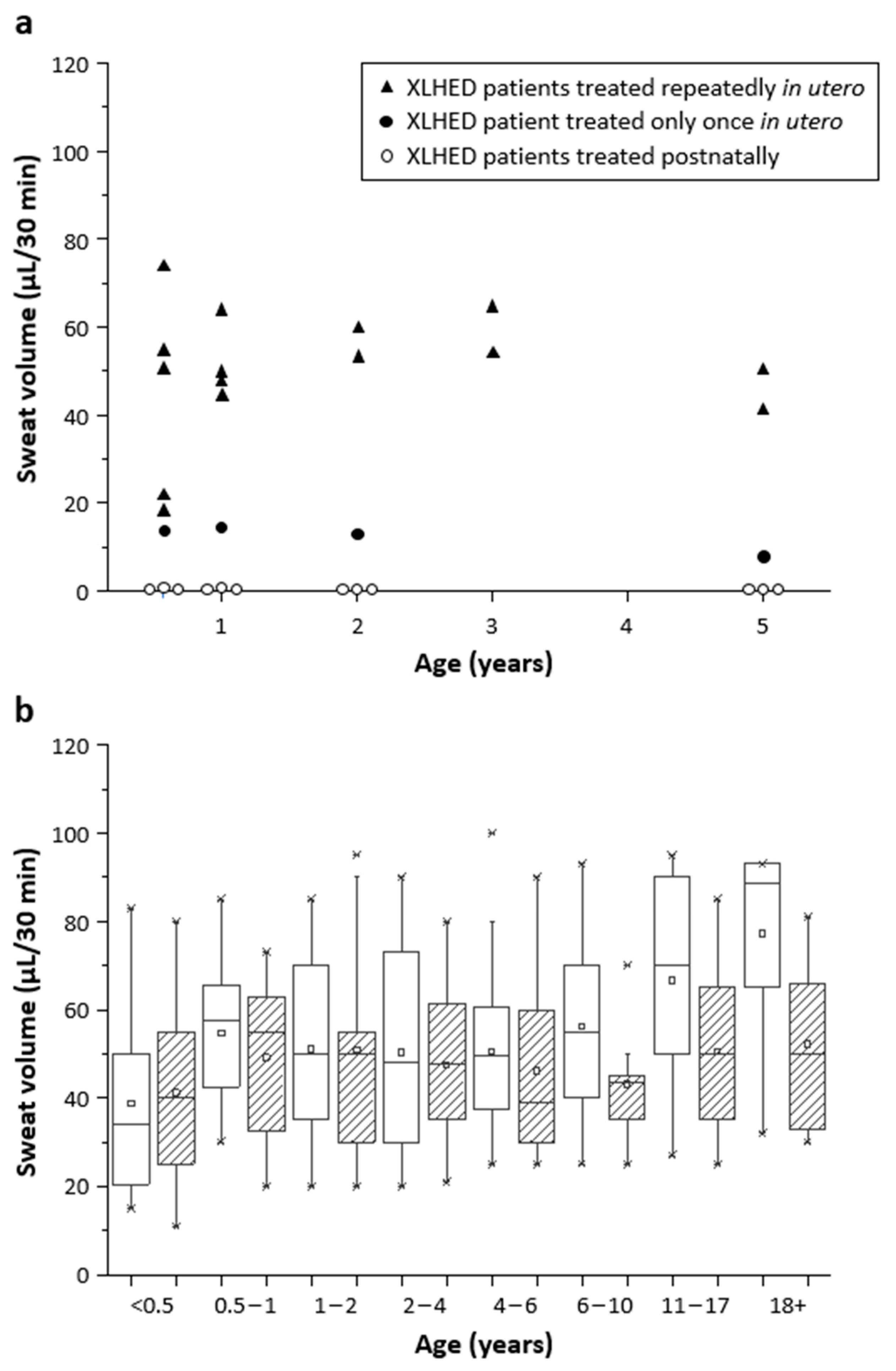
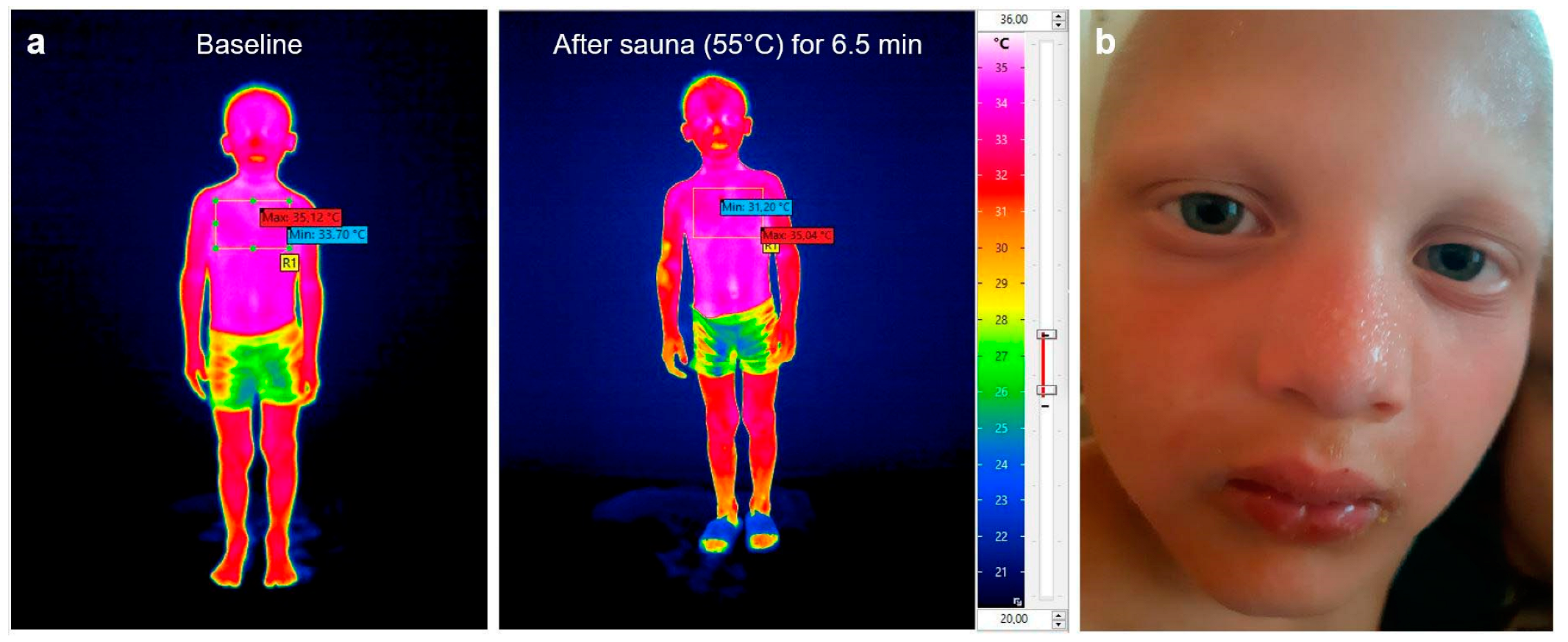
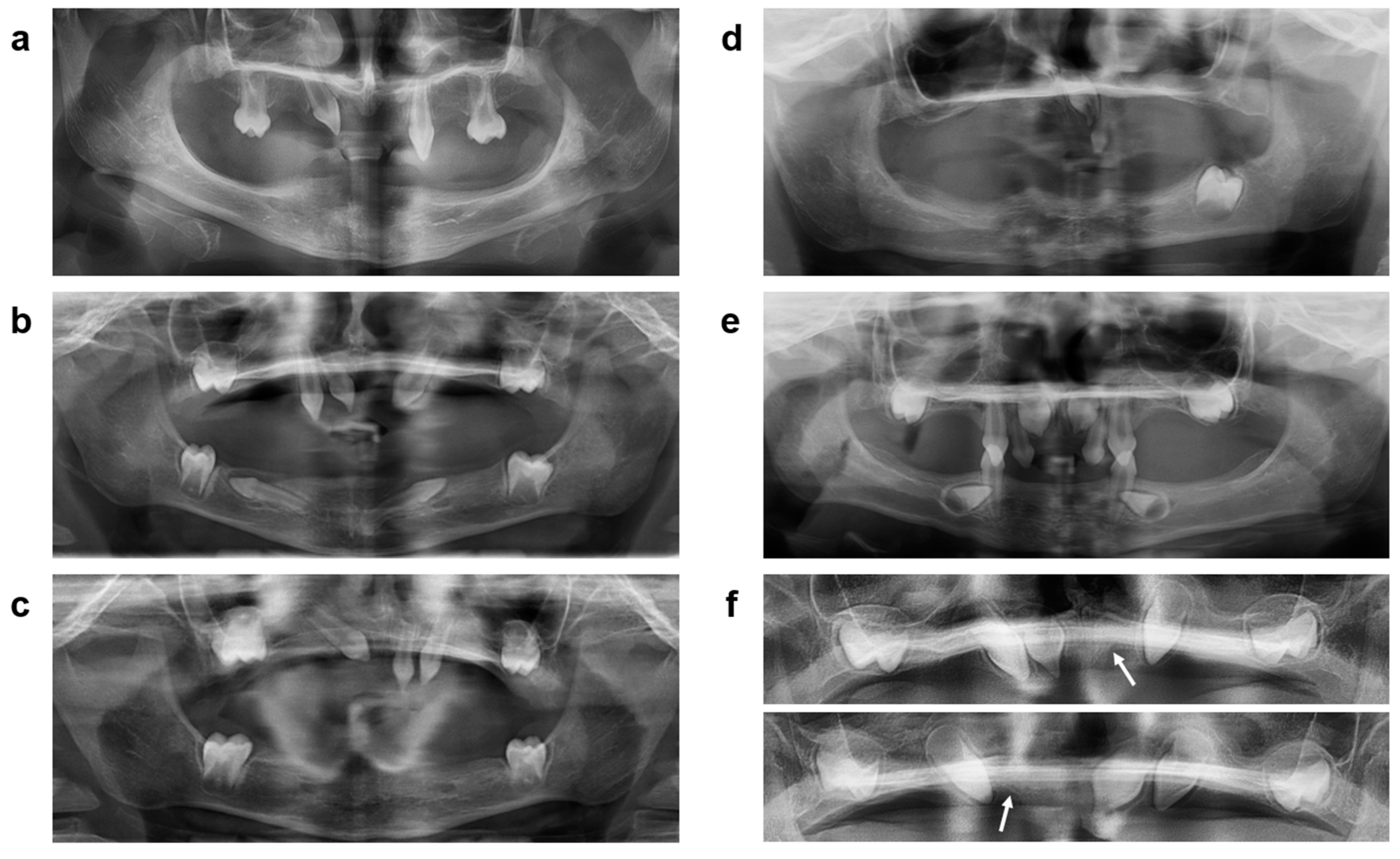
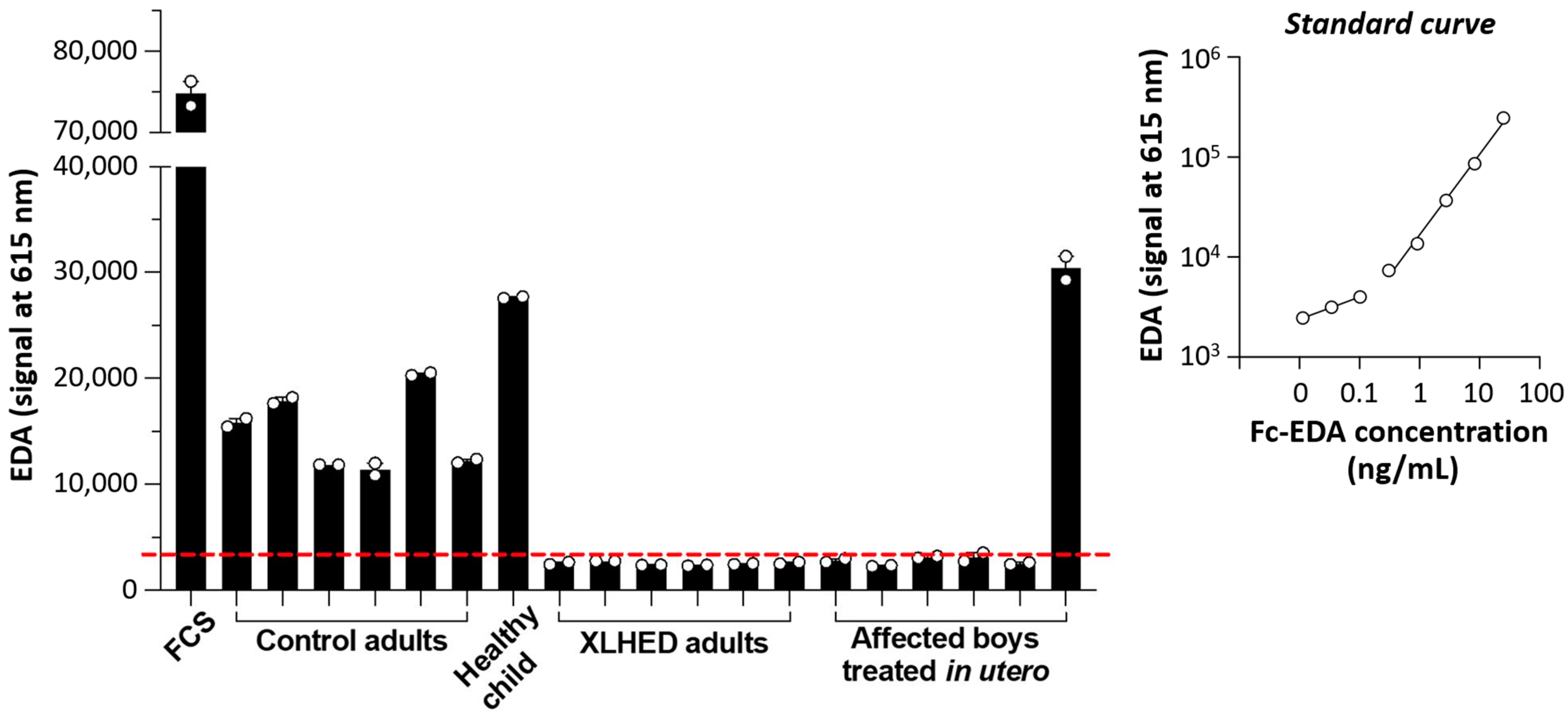

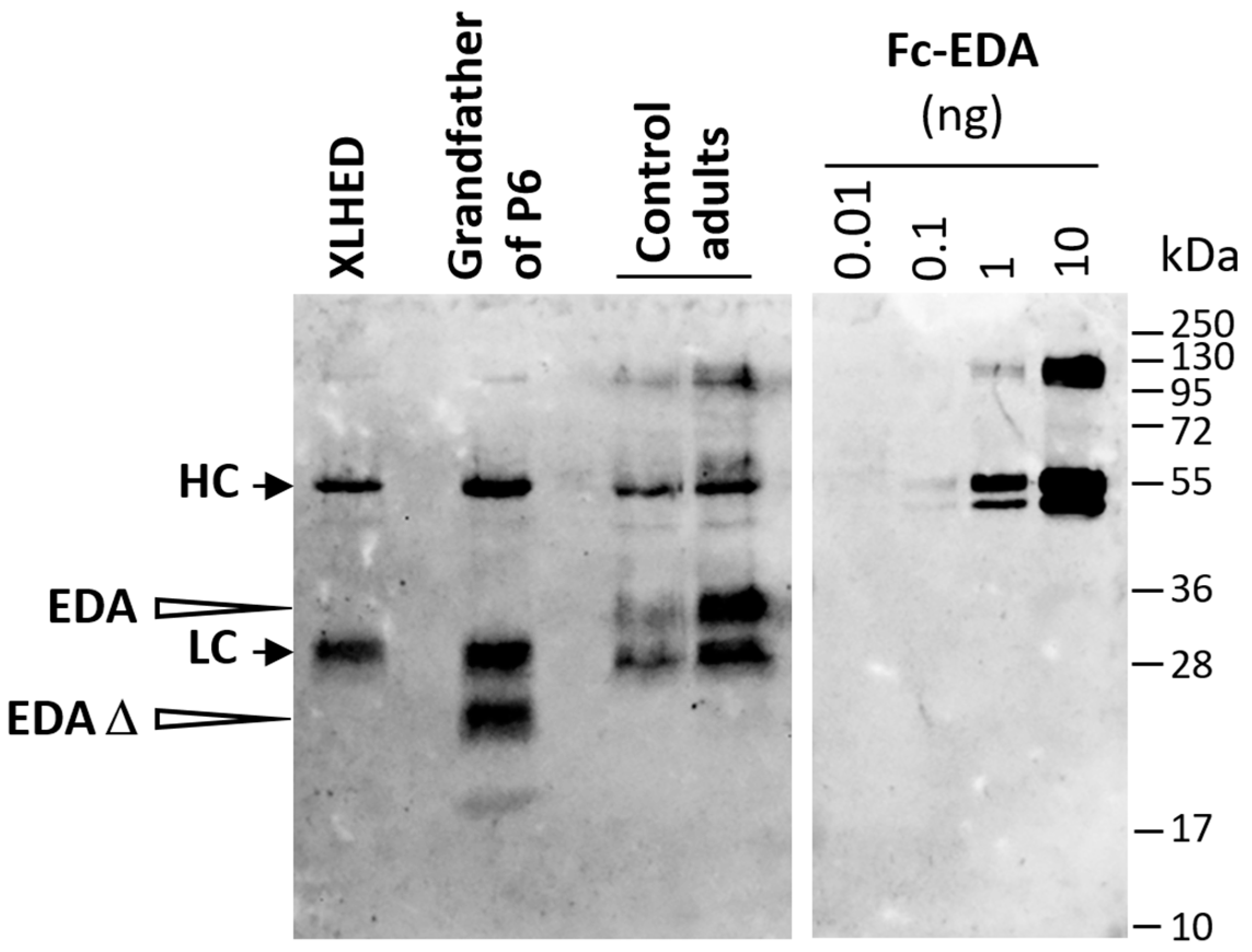
| Subject Code | Pathogenic EDA Variant | Predicted Molecular Effects | Functional Impact of the Mutation | Subject’s Age at First Treatment 1 | Year of Treatment |
|---|---|---|---|---|---|
| N1 | c.397-5858_502+3441dup; p.Gly168AspfsX10 | Truncated, non-functional EDA1 protein | Anhidrosis | 3 days | 2013 |
| N2 | c.925-3C>G | Altered mRNA splicing | Anhidrosis | 9 days | 2014 |
| N3 | c.463C>T; p.Arg155Cys | Impaired furin cleavage | Anhidrosis | 5 days | 2015 |
| P1 | c.911A>G; p.Tyr304Cys | Insoluble EDA1 protein | Anhidrosis | GA 25 weeks + 4 days | 2016 |
| P2 | c.911A>G; p.Tyr304Cys | Insoluble EDA1 protein | Anhidrosis | GA 25 weeks + 4 days | 2016 |
| P3 * | c.924+1dupG; p.V309GfsX8 | Truncated, non-functional EDA1 protein | Anhidrosis | GA 26 weeks + 6 days | 2016 |
| P4 | Deletion of exon 1 | Nonsense-mediated decay | Anhidrosis | GA 25 weeks + 1 day | 2020 |
| P5 | c.1133C>T; p.Thr378Met | Impaired receptor binding | Anhidrosis | GA 25 weeks + 6 days | 2020 |
| P6 | c.562_589del; p.Pro188ArgfsX83 | Truncated, non-functional EDA1 protein | Anhidrosis | GA 25 weeks + 2 days | 2021 |
| Subject |
Body Length (cm) 1 | Body Weight (kg) 1 | Primary Teeth (Number) | Permanent Teeth (Number) | Pilocarpine- Induced Sweating (µL/30 min) | Episodes of Hyperthermia during the Summer? | Dry Eye Issues? | Nosebleeds (Number per Year) | Repeated Airway Infections? | Dry Mouth? | Hoarse Voice? | Dry Skin? |
|---|---|---|---|---|---|---|---|---|---|---|---|---|
| N1 | 106.5 14th perc. | 18.7 42nd perc. | 2 | 4 | 0 | yes | yes | 5 | yes | yes | yes | yes |
| N2 | 109 26th perc. | 17.6 24th perc. | 8 | 5 | 0 | yes | yes | 50 | yes | yes | yes | yes |
| N3 | 110 40th perc. | 18.7 44th perc. | 1 | 2 | 0 | yes | yes | 4 | yes | yes | yes | yes |
| P3 (single dose) | 108 41st perc. | 18.8 56th perc. | 4 | 8 | 7 | no | no | 2 | no | no | no | yes |
| P1 (two doses) | 105 10th perc. | 16.2 11th perc. | 1 | 9 | 41 | no | no | 0 | no | no | no | no |
| P2 (two doses) | 106 14th perc. | 16.5 14th perc. | 1 | 7 | 50 | no | no | 0 | no | no | no | no |
Disclaimer/Publisher’s Note: The statements, opinions and data contained in all publications are solely those of the individual author(s) and contributor(s) and not of MDPI and/or the editor(s). MDPI and/or the editor(s) disclaim responsibility for any injury to people or property resulting from any ideas, methods, instructions or products referred to in the content. |
© 2023 by the authors. Licensee MDPI, Basel, Switzerland. This article is an open access article distributed under the terms and conditions of the Creative Commons Attribution (CC BY) license (https://creativecommons.org/licenses/by/4.0/).
Share and Cite
Schneider, H.; Schweikl, C.; Faschingbauer, F.; Hadj-Rabia, S.; Schneider, P. A Causal Treatment for X-Linked Hypohidrotic Ectodermal Dysplasia: Long-Term Results of Short-Term Perinatal Ectodysplasin A1 Replacement. Int. J. Mol. Sci. 2023, 24, 7155. https://doi.org/10.3390/ijms24087155
Schneider H, Schweikl C, Faschingbauer F, Hadj-Rabia S, Schneider P. A Causal Treatment for X-Linked Hypohidrotic Ectodermal Dysplasia: Long-Term Results of Short-Term Perinatal Ectodysplasin A1 Replacement. International Journal of Molecular Sciences. 2023; 24(8):7155. https://doi.org/10.3390/ijms24087155
Chicago/Turabian StyleSchneider, Holm, Christine Schweikl, Florian Faschingbauer, Smail Hadj-Rabia, and Pascal Schneider. 2023. "A Causal Treatment for X-Linked Hypohidrotic Ectodermal Dysplasia: Long-Term Results of Short-Term Perinatal Ectodysplasin A1 Replacement" International Journal of Molecular Sciences 24, no. 8: 7155. https://doi.org/10.3390/ijms24087155
APA StyleSchneider, H., Schweikl, C., Faschingbauer, F., Hadj-Rabia, S., & Schneider, P. (2023). A Causal Treatment for X-Linked Hypohidrotic Ectodermal Dysplasia: Long-Term Results of Short-Term Perinatal Ectodysplasin A1 Replacement. International Journal of Molecular Sciences, 24(8), 7155. https://doi.org/10.3390/ijms24087155





